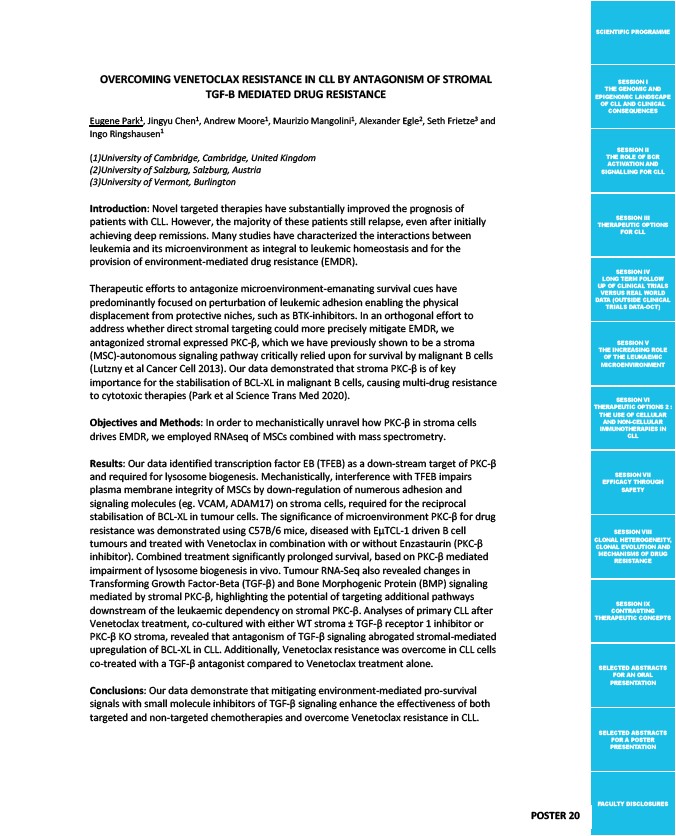
SCIENTIFIC PROGRAMME
SESSION I
THE GENOMIC AND
EPIGENOMIC LANDSCAPE
OF CLL AND CLINICAL
CONSEQUENCES
SESSION II
THE ROLE OF BCR
ACTIVATION AND
SIGNALLING FOR CLL
SESSION III
THERAPEUTIC OPTIONS
FOR CLL
SESSION IV
LONG TERM FOLLOW
UP OF CLINICAL TRIALS
VERSUS REAL WORLD
DATA (OUTSIDE CLINICAL
TRIALS DATA-OCT)
SESSION V
THE INCREASING ROLE
OF THE LEUKAEMIC
MICROENVIRONMENT
SESSION VI
THERAPEUTIC OPTIONS 2 :
THE USE OF CELLULAR
AND NON-CELLULAR
IMMUNOTHERAPIES IN
CLL
SESSION VII
EFFICACY THROUGH
SAFETY
SESSION VIII
CLONAL HETEROGENEITY,
CLONAL EVOLUTION AND
MECHANISMS OF DRUG
RESISTANCE
SESSION IX
CONTRASTING
THERAPEUTIC CONCEPTS
SELECTED ABSTRACTS
FOR AN ORAL
PRESENTATION
SELECTED ABSTRACTS
FOR A POSTER
PRESENTATION
FACULTY DISCLOSURES
OVERCOMING VENETOCLAX RESISTANCE IN CLL BY ANTAGONISM OF STROMAL
TGF-Β MEDIATED DRUG RESISTANCE
Eugene Park1, Jingyu Chen1, Andrew Moore1, Maurizio Mangolini1, Alexander Egle2, Seth Frietze3 and
Ingo Ringshausen1
(1)University of Cambridge, Cambridge, United Kingdom
(2)University of Salzburg, Salzburg, Austria
(3)University of Vermont, Burlington
I
ntroduction: Novel targeted therapies have substantially improved the prognosis of
patients with CLL. However, the majority of these patients still relapse, even after initially
achieving deep remissions. Many studies have characterized the interactions between
leukemia and its microenvironment as integral to leukemic homeostasis and for the
provision of environment-mediated drug resistance (EMDR).
Therapeutic efforts to antagonize microenvironment-emanating survival cues have
predominantly focused on perturbation of leukemic adhesion enabling the physical
displacement from protective niches, such as BTK-inhibitors. In an orthogonal effort to
address whether direct stromal targeting could more precisely mitigate EMDR, we
antagonized stromal expressed PKC-β, which we have previously shown to be a stroma
(MSC)-autonomous signaling pathway critically relied upon for survival by malignant B cells
(Lutzny et al Cancer Cell 2013). Our data demonstrated that stroma PKC-β is of key
importance for the stabilisation of BCL-XL in malignant B cells, causing multi-drug resistance
to cytotoxic therapies (Park et al Science Trans Med 2020).
Objectives and Methods: In order to mechanistically unravel how PKC-β in stroma cells
drives EMDR, we employed RNAseq of MSCs combined with mass spectrometry.
Results: Our data identified transcription factor EB (TFEB) as a down-stream target of PKC-β
and required for lysosome biogenesis. Mechanistically, interference with TFEB impairs
plasma membrane integrity of MSCs by down-regulation of numerous adhesion and
signaling molecules (eg. VCAM, ADAM17) on stroma cells, required for the reciprocal
stabilisation of BCL-XL in tumour cells. The significance of microenvironment PKC-β for drug
resistance was demonstrated using C57B/6 mice, diseased with EμTCL-1 driven B cell
tumours and treated with Venetoclax in combination with or without Enzastaurin (PKC-β
inhibitor). Combined treatment significantly prolonged survival, based on PKC-β mediated
impairment of lysosome biogenesis in vivo. Tumour RNA-Seq also revealed changes in
Transforming Growth Factor-Beta (TGF-β) and Bone Morphogenic Protein (BMP) signaling
mediated by stromal PKC-β, highlighting the potential of targeting additional pathways
downstream of the leukaemic dependency on stromal PKC-β. Analyses of primary CLL after
Venetoclax treatment, co-cultured with either WT stroma ± TGF-β receptor 1 inhibitor or
PKC-β KO stroma, revealed that antagonism of TGF-β signaling abrogated stromal-mediated
upregulation of BCL-XL in CLL. Additionally, Venetoclax resistance was overcome in CLL cells
co-treated with a TGF-β antagonist compared to Venetoclax treatment alone.
Conclusions: Our data demonstrate that mitigating environment-mediated pro-survival
signals with small molecule inhibitors of TGF-β signaling enhance the effectiveness of both
targeted and non-targeted chemotherapies and overcome Venetoclax resistance in CLL.
POSTER 20